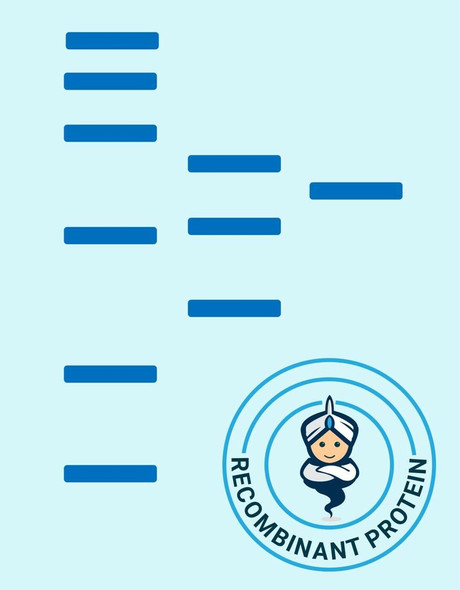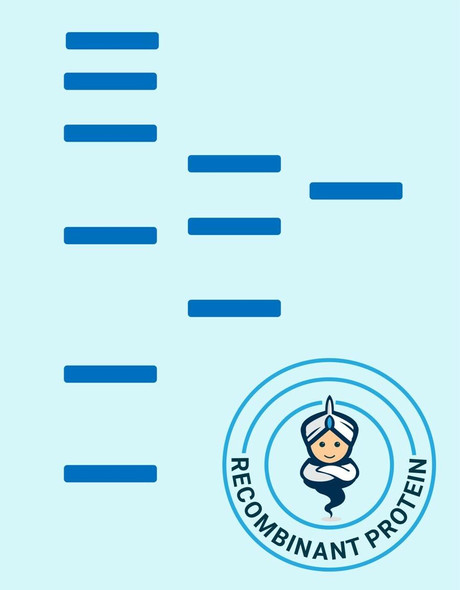Canine IL-4 Recombinant Protein (RPPB0512)
- SKU:
- RPPB0512
- Product type:
- Recombinant Protein
- Size:
- 100ug
- Species:
- Canine
- Target:
- IL-4
- Synonyms:
- BCGF
- BCDF
- B cell stimulating factor
- BSF-1
- Source:
- Escherichia Coli
- Uniprot:
- P05112
Description
| Product Name: | Canine IL-4 Recombinant Protein |
| Product Code: | RPPB0512 |
| Size: | 100µg |
| Species: | Canine |
| Target: | IL-4 |
| Synonyms: | BCGF, BCDF, B cell stimulating factor, BSF-1, Lymphocyte stimulatory factor 1, IL-4, MGC79402, Binetrakin, Pitrakinra. |
| Source: | Escherichia Coli |
| Physical Appearance: | Sterile Filtered White lyophilized (freeze-dried) powder. |
| Formulation: | The protein was lyophilized from a sterile (0.2µm) filtered solution containing 0.1% Trifluoroacetic Acid (TFA). |
| Solubility: | It is recommended to reconstitute the lyophilized IL-4 in sterile 18M?-cm H2O not less than 100µg/ml, which can then be further diluted to other aqueous solutions. |
| Stability: | Lyophilized IL-4 although stable at room temperature for 3 weeks, should be stored desiccated below -18°C. Upon reconstitution IL-4 should be stored at 4°C between 2-7 days and for future use below -18°C.Please prevent freeze-thaw cycles. |
| Purity: | Greater than 95.0% as determined by SDS-PAGE. |
| Amino Acid Sequence: | MHNFNITIKE IIKMLNILTA RNDSCMELTV KDVFTAPKNT SDKEIFCRAA TVLRQIYTHN CSNRYLRGLY RNLSSMANKT CSMNEIKKST LKDFLERLKV IMQKKYYRH |
| Biological Activity: | The ED50, as determined by TF-1 cell proliferation is <25ng/ml corresponding to a specific activity which is ? 4.0 x 10^4 units/mg. |
IL4 is a pleiotropic cytokine produced by activated T cells. IL4 is a ligand for interleukin 4 receptor. The interleukin 4 receptor also binds to IL13, which contributes to various overlapping roles of this cytokine and IL13. STAT6, a signal transducer and activator of transcription plays a main role in mediating the immune regulatory signal of this cytokine. IL4, IL3, IL5, IL13, and CSF2 form a cytokine gene cluster on chromosome 5q, with this gene particularly close to IL13. IL4, IL13 and IL5 are regulated co-ordinately by several long-range regulatory elements in an over 120 kilobase range on the chromosome.
Interleukin-4 Canine Recombinant produced in E. coli is a non-glycosylated monomer chain containing 109 amino acids and having a molecular mass of 12.9kDa.IL-4 is purified by proprietary chromatographic techniques.
| UniProt Protein Function: | IL4: Participates in at least several B-cell activation processes as well as of other cell types. It is a costimulator of DNA-synthesis. It induces the expression of class II MHC molecules on resting B-cells. It enhances both secretion and cell surface expression of IgE and IgG1. It also regulates the expression of the low affinity Fc receptor for IgE (CD23) on both lymphocytes and monocytes. Genetic variations in IL4 may be a cause of susceptibility to ischemic stroke (ISCHSTR); also known as cerebrovascular accident or cerebral infarction. A stroke is an acute neurologic event leading to death of neural tissue of the brain and resulting in loss of motor, sensory and/or cognitive function. Ischemic strokes, resulting from vascular occlusion, is considered to be a highly complex disease consisting of a group of heterogeneous disorders with multiple genetic and environmental risk factors. Belongs to the IL-4/IL-13 family. 2 isoforms of the human protein are produced by alternative splicing. |
| UniProt Protein Details: | Protein type:Cell cycle regulation; Cytokine; Motility/polarity/chemotaxis; Secreted; Secreted, signal peptide Chromosomal Location of Human Ortholog: 5q31.1 Cellular Component: extracellular space; external side of plasma membrane Molecular Function:protein binding; growth factor activity; cytokine activity; interleukin-4 receptor binding Biological Process: regulation of isotype switching; positive regulation of isotype switching to IgG isotypes; negative regulation of osteoclast differentiation; positive regulation of transcription, DNA-dependent; microglial cell activation; regulation of proton transport; female pregnancy; positive regulation of activated T cell proliferation; chemotaxis; response to organic cyclic substance; positive regulation of isotype switching to IgE isotypes; positive regulation of interleukin-10 production; B cell costimulation; connective tissue growth factor biosynthetic process; positive regulation of MHC class II biosynthetic process; positive regulation of B cell proliferation; positive regulation of T cell proliferation; positive regulation of interleukin-13 production; negative regulation of macrophage activation; response to nutrient; response to drug; cholesterol metabolic process; regulation of immune response; negative regulation of chronic inflammatory response; T-helper 2 type immune response; regulation of phosphorylation; B cell activation; negative regulation of nitric oxide biosynthetic process; negative regulation of acute inflammatory response; defense response to protozoan; T-helper 1 cell lineage commitment; response to ethanol; positive regulation of chemokine biosynthetic process; positive regulation of tyrosine phosphorylation of Stat5 protein; positive regulation of T cell differentiation; innate immune response in mucosa; retina development in camera-type eye; B cell differentiation; response to cytokine stimulus; cellular defense response; immune response; positive regulation of transcription from RNA polymerase II promoter; positive regulation of transcription factor activity; T-helper 2 cell differentiation; negative regulation of transcription, DNA-dependent; positive regulation of defense response to virus by host; negative regulation of apoptosis Disease: Stroke, Ischemic |
| NCBI Summary: | The protein encoded by this gene is a pleiotropic cytokine produced by activated T cells. This cytokine is a ligand for interleukin 4 receptor. The interleukin 4 receptor also binds to IL13, which may contribute to many overlapping functions of this cytokine and IL13. STAT6, a signal transducer and activator of transcription, has been shown to play a central role in mediating the immune regulatory signal of this cytokine. This gene, IL3, IL5, IL13, and CSF2 form a cytokine gene cluster on chromosome 5q, with this gene particularly close to IL13. This gene, IL13 and IL5 are found to be regulated coordinately by several long-range regulatory elements in an over 120 kilobase range on the chromosome. Two alternatively spliced transcript variants of this gene encoding distinct isoforms have been reported. [provided by RefSeq, Jul 2008] |
| UniProt Code: | P05112 |
| NCBI GenInfo Identifier: | 124337 |
| NCBI Gene ID: | 3565 |
| NCBI Accession: | P05112.1 |
| UniProt Secondary Accession: | P05112,Q14630, Q6NZ77, |
| UniProt Related Accession: | P05112 |
| Molecular Weight: | 15,797 Da |
| NCBI Full Name: | Interleukin-4 |
| NCBI Synonym Full Names: | interleukin 4 |
| NCBI Official Symbol: | IL4 |
| NCBI Official Synonym Symbols: | BSF1; IL-4; BCGF1; BSF-1; BCGF-1 |
| NCBI Protein Information: | interleukin-4; binetrakin; pitrakinra; B cell growth factor 1; interleukin 4 variant 2; B_cell stimulatory factor 1; lymphocyte stimulatory factor 1 |
| UniProt Protein Name: | Interleukin-4 |
| UniProt Synonym Protein Names: | B-cell stimulatory factor 1; BSF-1; Binetrakin; Lymphocyte stimulatory factor 1; Pitrakinra |
| Protein Family: | Interleukin |
| UniProt Gene Name: | IL4 |
| UniProt Entry Name: | IL4_HUMAN |






